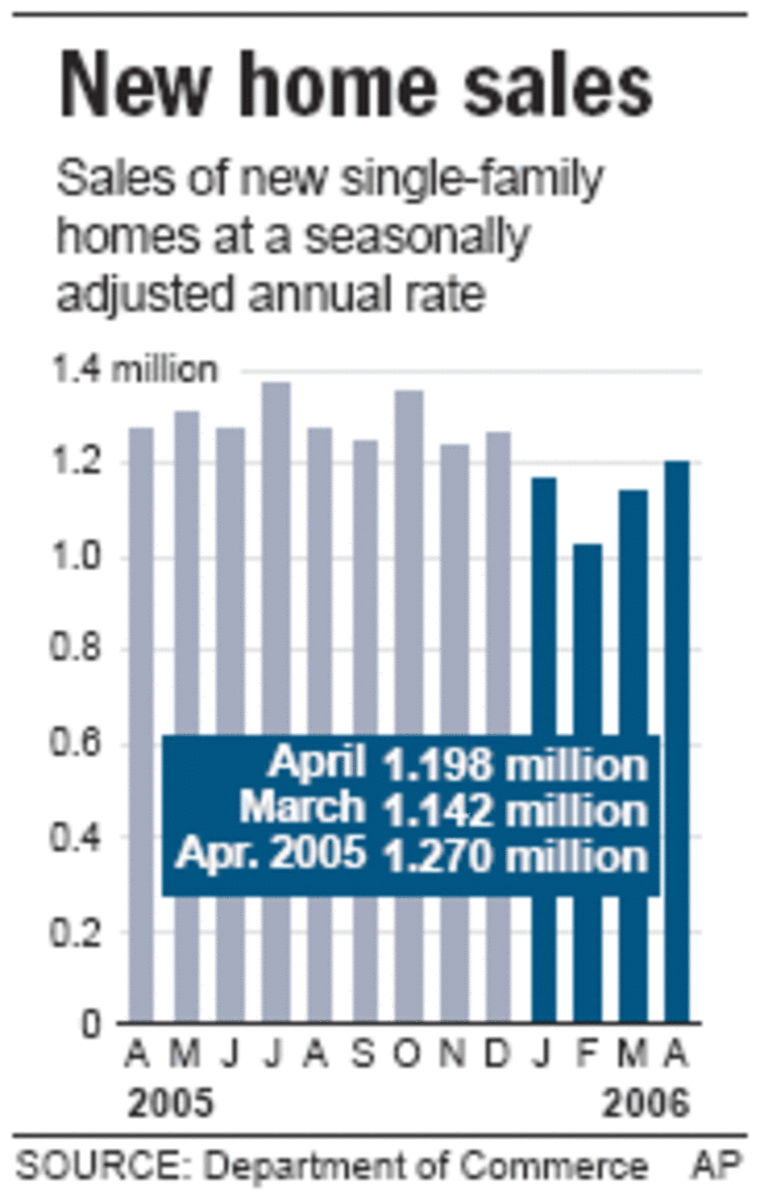Defying forecasts of an imminent slowdown, sales of new homes shot up in April to the fastest sales pace this year. But prices were up only slightly, and the backlog of unsold homes hit a new record.
The Commerce Department reported Wednesday that sales of new single-family homes increased by 4.9 percent last month to a seasonally adjusted annual rate of 1.198 million units, the highest rate since last December.
Economists, who had been forecasting a sales decline in April, said the increase had been skewed by the fact that the government lowered sales activity significantly in prior months.
Also, they noted that the number of unsold homes remaining on the market at the end of April rose to the highest level on record, an overhang that they predicted would depress prices going forward.

The median price of a new home sold in April was $238,500, up just 0.9 percent from a year ago, far below the double-digit price gains sellers were enjoying last year at the peak of the housing boom.
“Housing is holding up better than we had thought given how much mortgage rates have gone up, but we still expect it to weaken as the year goes forward,” said David Wyss, chief economist at Standard & Poor’s in New York.
Wyss said he expected home sales would drop by 10 percent this year and that construction of new homes and apartments would be down by about 8 percent.
On Wall Street, the Dow Jones industrial average finished an erratic session posting a modest gain of 18.97 points to close at 11,117.32.
The housing slowdown is coming after five years in which sales of both new and existing homes hit consecutive sales records as buyers enjoyed the lowest mortgage rates in four decades.
The National Association of Realtors is scheduled to report on existing home sales, which represent four-fifths of the total home market, on Thursday with expectations of a 2.5 percent decline.
The Federal Reserve has been raising short-term interest rates for nearly two years and those increases are finally starting to trigger a sustained rise in long-term borrowing costs. The rate on 30-year mortgages hit a nearly four-year high of 6.60 percent last week.
Federal Reserve Chairman Ben Bernanke said last week that he believed the housing market, which has been a key driver of the U.S. economy, was cooling but that it appeared to be a “very orderly and moderate kind of cooling.”
But some economists are worried that the slowdown could be more severe, mirroring the disruptions caused when the stock market bubble burst in early 2000.
Peter Schiff, president of Euro Pacific Capital, a brokerage firm in Darien, Conn., said sales of new homes are coming at the expense of existing home sales as buyers respond to aggressive incentive offers builders are using to move unsold homes.
Once existing homeowners realize they will have to lower their asking price to make a sale, this could cause a sharp drop in sales prices around the country, Schiff said.
The backlog of unsold new homes rose by 2.4 percent to a new record of 565,000 homes on the market at the end of April. It would take 5.8 months to deplete that backlog at the April sales pace.
Home sales were strong in all parts of the country last month except the Midwest, where sales fell by 1.1 percent, the second straight monthly decline.
Sales were up 8.2 percent in the Northeast, 7.8 percent in the South and 2 percent in the West.
Many economists believe the slowdown in housing will be gradual as long as inflation pressures remain moderate enough to allow the Fed soon to take a pause in its two-year campaign to push interest rates higher.
In other economic news, orders to U.S. factories for big-ticket manufactured goods fell 4.8 percent in April, the largest amount in three months, as aircraft orders plunged by 32.2 percent and demand for computers and other electronic products dropped by the largest amount in nearly six years.
However, analysts said this decline overstated the weakness in manufacturing, which they said should still show strong gains in coming months, reflecting lean inventory levels and a drive by businesses to boost capital investments.
That strength is expected to partially cushion the economy from the adverse effects of a slowdown in housing.